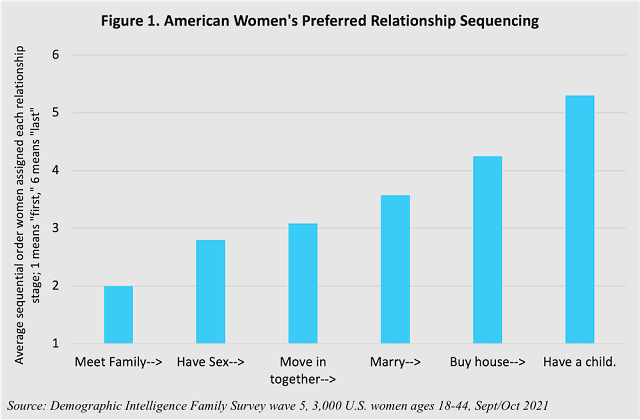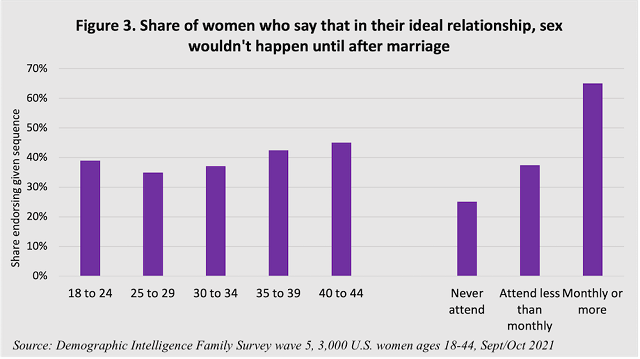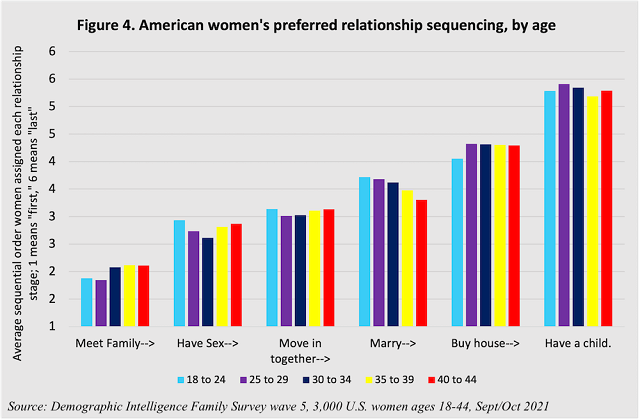Highlights
- Women overwhelmingly selected “meeting each others’ families” as their preferred first relationship step out of six choices, per a recent survey. Post This
- Among women who never attend religious services, about 25% prefer to postpone sex until after marriage. But among regular church-going women, about 65% prefer that more traditional arrangement. Post This
- While about 70 to 75% of women in fact cohabit before marriage, only 65% of women in a recent survey said that was what they preferred. Post This
In America today, around 70% of people cohabit before marriage, and almost 90% have sex before they marry. Moreover, around 40% of kids are born to unmarried moms. It’s easy to assume these trends are driven entirely by shifts in values and attitudes like the Sexual Revolution or the deinstitutionalization of marriage. But there’s an alternative thesis as well: maybe family breakdown has grown not because people don’t desire the conventional sequence of marriage and childbearing, but because there are obstacles to this outcome. The prevalence of damaging penalties that discourage marriage for working-class people could be preventing many from achieving the family lives they want. And indeed, family dissolution and marriage penalties are major issues of concern for working-class parents.
To explore the question of why the sequencing of family events has changed, I fielded a survey of 3,000 U.S. women ages 18 to 44. The survey was another wave of a long-running survey called the Demographic Intelligence Family Survey, which polls American women about their family attitudes, fertility preferences, and lifestyles twice a year to provide market research for companies that make products for children and moms, hence why it only surveyed women. I assessed sequencing in a straightforward way: I asked women to arrange six relationship stages based on what they thought would be the “best order” for them “personally.” The six stages were: getting married, moving in together, having a child, buying a house, meeting each others’ families, and having sex (option order was randomized for each respondent).1 By forcing respondents to put these stages in order, I directly measured women’s views of what they would personally prefer for their own relationships. In other words, I measured the extent to which high rates of cohabitation and premarital sex reflect explicit values differences. Figure 1 shows the ”average rank order” assigned to each stage, from first to last.

Note: Responses arranged by average order. For example, the average rank assigned to "meet family"
was 2. In greater detail, 48% of women put "meet family" first, 31% put it second, 8% put it third, and
4% put it in fourth, fifth, or sixth, respectively, for an average placement of 2.
Contrary to popular Hollywood-driven narratives that frame “meeting the family” as a huge relationship step that people want to postpone, women overwhelmingly selected “meeting each others’ families” as their preferred first step out of these six. On average, meeting family was the second item listed (no item can be the first listed “on average” unless a huge majority put it first, but no single response had a majority of respondents putting it first or last).
While this may seem counterintuitive, it’s actually very straightforward: many women are saying they prefer to be in a relationship with someone who already knows their life and background, not a stranger. Other women may explicitly desire familial approval for partners. Furthermore, it’s important to remember the question asked women about what would be best, not typical. If women knew up front that their potential partner was their best possible partner, they might move faster on meeting families. Possibly subpar partners, or partners whose quality is in doubt, might not be introduced for some time. In the real world, a lot of the men that women date are not even candidates for a “best relationship.” Many people enter relationships they don’t expect to see last. As a result, the responses women gave here may not reflect their desires for their typical relationships: they reflect how these women would want things to happen if they found a “keeper.”
The second-most popular “first stage” after meeting the family was having sex. In fact, almost 80% of women in the survey listed either meeting family or having sex as their first step. After sex, the most common next step was moving in together, then marriage, then buying a home, then having a child.
The place of children is also striking, and points to a key breakdown between the behaviors that lead to individual success and the behaviors that lead to healthy societies. Most American women think you should own a home before having a child; in fact, 78% of women in this survey picked an ordering that placed home ownership before kids. In reality, American Community Survey data suggests around 40-50% of firstborn children are to renters. Home ownership is a strong indicator of financial stability, and so prioritizing home ownership before childbearing reveals a strong commitment to prioritizing a high level of material security before making progress on family goals. However, it’s also an absurd commitment: many financially healthy people rent. My wife and I have two children and are on our fourth rented apartment, and our kids are fine. Nor is it even clear why a person would want to own a home before having a child: the home that’s best for having one child is very different from the best home for two or three or four kids; renting during those early transitions may be very prudent. Indeed, the choice to position children as the very last step is consistent with the emerging norm of “capstone parenting,” meaning the recasting of the parent role as a crown jewel of a successful life, rather than part of personal development acquired along the way. When many people in our society believe that excessively high material achievement is necessary before having kids, the consequences of waiting too long are severe and include low fertility rates, huge gaps between desired and achieved fertility, and disappointed family hopes.
The survey also asked women if housing costs had impacted their family decisions. Among women who said kids should come before a house, 16% said housing costs had impacted their family decisions. But among women who said a house should come first, 38% said housing costs had impacted their decisions. This is an enormous gap. That gap was similar around the country as well: in high- and low-housing cost states alike, women’s odds of reporting that house prices impacted their family decisions were influenced by beliefs about buying a home before having kids. Women facing identical objective housing markets had very different perceptions of whether housing costs were a barrier to having kids, with those perceptions shaped by whether or not they felt a house or children should come first.
Other important differences emerge as well. Figure 2 below shows a few summarized sequencing patterns.

Note: Responses arranged by popularity of given sequence. These sequences are without
reference to other sequence components; for example, respondents are coded as "Premarital
cohabitation" if they report cohabitation immediately before marriage, or cohabitation then
home purchase, then marriage, or cohabitation then family, then child, then marriage, etc.
Although almost 90% of women have premarital sex, only 60% of women say they actually prefer to put sex before marriage in a relationship. Of those women, 30% listed sex as the first of the six stages identified, before meeting family. Similarly, while about 70 to 75% of women in fact cohabit before marriage, only 65% of women said that was what they preferred. For both of these, it’s clear that women have more socially conservative relationship preferences than they actually experience.
When it comes to child timing, 10% of women in the survey reported wanting children before sex. This isn’t a case of biological ignorance: many of these women already have children, and many of them report very socially progressive values. These are women who simply don’t see a need to have a partner involved in parenting; they already had a child, perhaps through a prior relationship, IVF, or adoption. For these women, childbearing and partnership are severable.
As already discussed, only about 20% of women thought it would be best to have a child before a house, and 60% of women wanted to meet a partner’s family before having sex. But what is more striking is that only 5% of women put marriage last. Respondents were instructed that if they didn’t want something at all that they should put it last. Some women might have had multiple stages they never wanted, but even including second-to-last orders for marriage, at least 90% of women said that marriage is part of their ideal relationship. Despite premarital sex and cohabitation being normative, the overwhelming majority of women still desire marriage. And as it turns out, 87% of them want marriage before childbearing, even though 40% of children will be born to unmarried moms.
Finally, it’s worth highlighting a few differences by important subgroups. Figure 3 shows the share of women who prefer to wait until marriage to have sex, by age group and religious attendance frequency.

Note: Same response definition as for Figure 2, but now showing prevalence by different subgroups.
There is not much difference by age group in terms of prioritization of marriage before sex. In fact, “Gen Z” looks more conservative than their immediate elders. But there are huge differences by religious attendance. Among women who never attend religious services, about 25% prefer to postpone sex until after marriage. But among regular church-going women, about 65% prefer that more traditional arrangement.
In fact, the relative lack of a trend across age groups is consistent across the dataset. Figure 4 below replicates Figure 1, but shows average rankings given for each age group. As you can see, there isn’t much change across the generations. Younger Americans may put a slightly higher priority on meeting family and a lower priority on sex, and across time there has been an extremely modest shift away from marriage. But the overwhelming impression of Figure 4 is of stability. There aren’t big age differences in ideal relationship sequencing.

Note: Responses arranged by average order within each age group. For example, "Meet family"
had an average order of 1.88 for women ages 18 to 24, 1.85 for women ages 25 to 29, 2.08 for
women ages 30 to 34, 2.12 for women ages 35 to 39, and 2.11 for women ages 40 to 44. Thus,
younger women put meeting family earlier in their preferred relationship sequence.
Overall, it’s clear that American women are not getting what they want from their relationships. Many women are being nudged (whether by partners or society on the whole is unclear) into sexual unions and cohabitations they don’t see as ideal. Overwhelming majorities of women desire marriage, yet for many it never comes, or comes too late to have a child. The dominant normative vision for relationship patterns erects high material burdens before childbearing, with the result that women feel that the costs of childbearing are insurmountable. And across several birth cohorts, American women don’t show much difference in their desired relationship sequences. Premarital sex is not getting more popular over time, for example, and the average ideal relationship sequence is identical for every age group. On the other hand, religiosity is a strong predictor of differences in desired relationship sequences. More religious women tend to desire to postpone sex until after marriage, to meet their partner’s family earlier, and to desire marriage earlier.
Lyman Stone is a Research Fellow at the Institute for Family Studies and Chief Information Officer of the population research firm Demographic Intelligence.
1. Note: Original survey question as it appeared to respondents:













